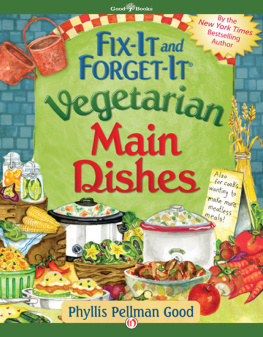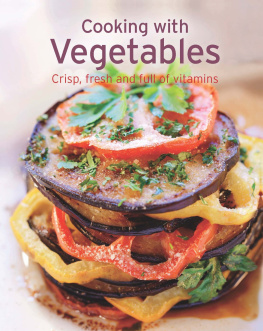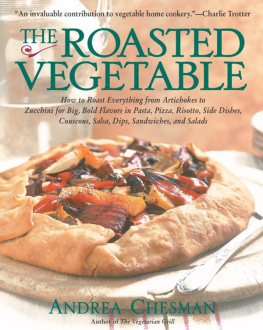Recipes from the Root Cellar
RECIPES From the ROOT CELLAR
250 Fresh Ways to Enjoy Winter Vegetables
Andrea Chesman

To the farmers who keep us well stocked with wonderful vegetables all through the year.
The mission of Storey Publishing is to serve our customers by publishing practical information that encourages personal independence in harmony with the environment.
Edited by Margaret Sutherland and Nancy Ringer
Art direction and book design by Mary Winkelman Velgos
Text production by Vicky Vaughn Shea/Ponderosa Pine Design
and Jennifer Jepson Smith
Illustration by Susy Pilgrim Waters
Indexed by the author
2010 by Andrea Chesman
All rights reserved. No part of this book may be reproduced without written permission from the publisher, except by a reviewer who may quote brief passages or reproduce illustrations in a review with appropriate credits; nor may any part of this book be reproduced, stored in a retrieval system, or transmitted in any form or by any means electronic, mechanical, photocopying, recording, or other without written permission from the publisher.
The information in this book is true and complete to the best of our knowledge. All recommendations are made without guarantee on the part of the author or Storey Publishing. The author and publisher disclaim any liability in connection with the use of this information.
Storey books are available for special premium and promotional uses and for customized editions. For further information, please call 1-800-793-9396.
Storey Publishing
210 MASS MoCA Way
North Adams, MA 01247
www.storey.com
Printed in the United States by Versa Press
10 9 8 7 6 5 4 3 2 1
LIBRARY OF CONGRESS CATALOGING-IN-PUBLICATION DATA
Chesman, Andrea.
Recipes from the root cellar / by Andrea Chesman.
p. cm.
Includes index.
ISBN 978-1-60342-545-2 (pbk. : alk. paper)
1. Cookery, American. 2. Cookery (Vegetables) I. Title.
TX715.C52456 2010
641.5973dc22
2010009608
Preface
It all started when I fell in love with salsify, a root vegetable that once graced the tables of many a colonial American kitchen but has since fallen out of favor. Salsify, also known as oyster plant, is said to taste a bit like oysters. Being a major fan of oysters, I thought: What could be better than a root vegetable that lasts and lasts in a root cellar and tastes like oysters even though it grew in my landlocked garden?
I planted my first crop of salsify about 30 years ago. It is a stubborn vegetable to grow. As it emerges from the soil, it looks a lot like grass, so it is easy to weed away the entire crop. And so went the first harvest. After learning from that mistake, I planted again, only to be defeated by clay soil. Salsify likes a deep, loose loam and will produce only the skinniest, gnarliest, and most miserable roots if it isnt given the loose soil it likes. A vigorous and early thinning also is absolutely necessary to give the roots sufficient space. Did I mention that this plant is fussy about its growing conditions?
But the flavor! Even a meager harvest is worth the labor. Sauted in butter, salsify has none of the cabbagey nuance of turnips and rutabagas, nor the (sometimes) overwhelming sweetness of carrots and beets. It tastes like, well, a cross between globe artichokes and Jerusalem artichokes. I think it is a terrific vegetable, but so demanding of my care as a gardener that I decided to form an organization called the National Association of Growers of Salsify (NAGS). As the founder of NAGS, my mission was to try and convince vegetable growers to tackle this challenging vegetable.
I wrote an open letter to the newsletter of the Middlebury Natural Foods Co-op, where I shop, entreating members to join NAGS. I promised no dues, no meetings, no t-shirts, no newsletter, no tote bags just the satisfaction of promoting the spread of this worthy vegetable.
Have you even ever heard of salsify? No? Well, then you know how successful NAGS has been.
By now most adventurous eaters have tasted their way around the globe. On demand, our supermarkets have stocked exotic fruits and vegetables from all over the planet, and the distinct flavors of Southeast Asia, Mexico, and Italy have profoundly changed the way we cook. We have dined on asparagus in January and come to regard the tomato as a year-round vegetable instead of the seasonal treat it truly is.
Eat locally, spice globally are the watchwords that have recently begun to inform tables across America. Best-selling works by Michael Pollen (The Omnivores Dilemma) and Barbara Kingsolver (Animal, Vegetable, Miracle) have strongly influenced people to think about the choices they make when shopping for food and to buy locally grown foods that have not been shipped over long distances, accumulating many food miles. This in turn means eating seasonal foods, at their peak, and fits in nicely with a growing aesthetic that celebrates fresh foods in their seasons. Eating locally means continuing the practice of enjoying the flavors of all the great cuisines of the world, while focusing the bulk of our choices on the foods that grow close to home.
The United States is blessed with a variety of different climates, but almost all locales experience some sort of winter, when few, if any, crops can be grown. Fortunately a variety of vegetables store well and can be enjoyed fresh instead of frozen or canned. These include root vegetables, hard-shelled winter squashes, and hardy greens that hold up well in the cold. Dried beans are another vegetable that keeps through the winter; heart-healthy, full of fiber, inexpensive, easily stored, and delicious, they make a lot of sense in the modern diet.
In recent years, I have grown to have a greater appreciation of turnips and rutabagas. I have served Brussels sprouts to a friend who said it was the first time she had enjoyed them, because I roasted them. I have made peace with parsnips, particularly if they are roasted. Kale is such a favored vegetable in my household that we actually miss it in the summer.
The hardy greens, winter squashes, and root vegetables have been largely ignored in recent years as people have been tempted by the unfamiliar and exotic. But a number of factors have converged to make eating long-keeping winter vegetables a good choice. Between an awareness that processed and exotic foods bring with them a significant carbon footprint and a shortfall in many household economies in the grip of a global recession, eating more humble vegetables makes sense. A lot of sense.
It is time for a rediscovery and celebration of the humble vegetables that have sustained so many people for so long before the advent of transcontinental shipping and overnight transoceanic flights. And if this includes a rediscovery of an unfamiliar root vegetable like salsify, then so much the better.
Eat More Vegetables
While dietary wisdom changes seasonally, the one piece of advice that never alters is eat more vegetables. It turns out that a diet filled with winter vegetables isnt boring at all. The variety of dishes one can enjoy is infinite, and this collection of more than 250 recipes is only a beginning.
One theme that emerged in my experiments with using only winter vegetables in the winter is that favorite dishes are easily adapted. We love California nori rolls, a vegetarian sushi roll usually made with avocado, carrot, and scallions. Well, my experiments revealed that nori rolls made with carrots, turnips, and red cabbage are even more beautiful to behold and equally tasty. Love New England clam chowder? Try a scallop-and-salsify chowder. Love beef stew? Choose roots for the vegetables. This isnt about applying some abstract locavore discipline. This is just good eating.
Next page










